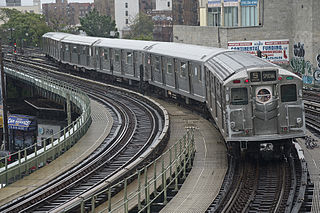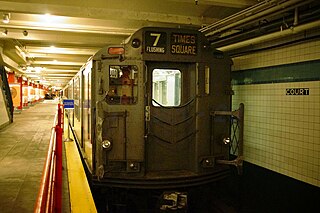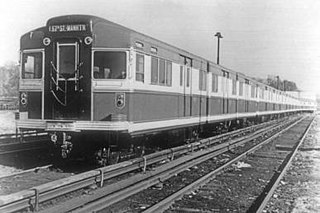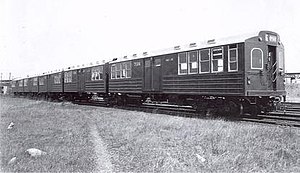
The R32 was a New York City Subway car model built by the Budd Company from 1964 to 1965 for the IND/BMT B Division. A total of 600 R32s were built, numbered 3350–3949, though some cars were re-numbered. The R32 contract was divided into two subcontracts of 300 cars each: R32 and R32A ; the former was paid by the city's capital budget and the latter was paid through a revenue bond. All were arranged as married pairs.

The R44 is a New York City Subway car model built by the St. Louis Car Company from 1971 to 1973 for the B Division and the Staten Island Railway (SIR). The cars replaced many R1-R9 series cars, and all remaining 1925 Standard Steel built SIRTOA ME-1 trains, providing Staten Island with a new fleet of railcars. The R44 fleet originally consisted of 352 cars, of which 57 remain in service, all on the Staten Island Railway.

The R1-9s were the 1,703 similar New York City Subway cars built between 1930 and 1940 for the Independent Subway System. All were built by the American Car and Foundry Company, the Pressed Steel Car Company, and Pullman Standard. The name comes from the literal spelling out of the final contract under which these 1,703 cars were ordered – contract "R9".

BU cars is the generic term for BRT elevated gate cars used on predecessor lines of the New York City Subway system. Various orders of these cars were built by the Osgood-Bradley, Brill, Cincinnati, Laconia, Pullman, Gilbert & Bush, Harlan & Hollingsworth, Wason, Pressed Steel, Brooklyn Heights Railroad, John Stephenson, and Jewett car companies.

The Budd Company was a 20th-century metal fabricator, a major supplier of body components to the automobile industry, and a manufacturer of stainless steel passenger rail cars, airframes, missile and space vehicles, and various defense products.

The R6 was a New York City Subway car model built from 1935 to 1936 for the city-operated Independent Subway System by three manufacturers under separate orders, the American Car and Foundry Company, Pullman Standard, and Pressed Steel Car Company. A total of 500 cars were built, numbered 900–1399, and arranged as single units. There were three versions of the R6: R6-1, R6-2, and R6-3. The R6s were a continuation of the R4 fleet and look almost the same, except that the R6 had a two-pane front window compared to the R4's one-pane window.

The R11 was a prototype class of experimental New York City Subway cars built by the Budd Company in 1949 for the IND/BMT B Division. A total of ten cars were built, arranged as single units. Originally consisting of 400 cars, only ten R11s were built, due to the cancellation of the Second Avenue Subway.

The R10 was the first series of post-war New York City Subway cars. They were built by the American Car and Foundry Company from 1948 to 1949 for the IND/BMT B Division. A total of 400 cars were built, arranged as single units. Two versions were manufactured: Westinghouse (WH)-powered cars and General Electric (GE)-powered cars. The R10s introduced many innovations, including an all-welded low-alloy high tensile (LAHT) steel construction, dynamic braking, improved propulsion, and various cosmetic features.

The R12 was a New York City Subway car built by the American Car and Foundry Company in 1948. A total of 100 cars were built, arranged as single units. Two versions were manufactured: Westinghouse (WH)-powered cars and General Electric (GE)-powered cars.

The Bluebird, formally dubbed Compartment Car by its purchaser, the Brooklyn–Manhattan Transit Corporation (BMT), was an advanced design PCC streetcar-derived subway and elevated railway car built by the Clark Equipment Company from 1938 to 1940 and used on the New York City Subway system from 1939 to 1955. A total of six units were built, with one prototype and five production units. They were among the last cars to be ordered by the BMT before the city takeover in 1940.

The R21 was a New York City Subway car built by St. Louis Car Company from 1956 to 1957 for the IRT A Division. A total of 250 cars were built, arranged as single units. Two versions were manufactured: Westinghouse (WH)-powered cars and General Electric (GE)-powered cars.

The R16 was a New York City Subway car model built by the American Car and Foundry Company from 1954 to 1955 for the IND/BMT B Division. A total of 200 cars were built, arranged as single units. Two versions were manufactured: Westinghouse (WH)-powered cars and General Electric (GE)-powered cars.

The R27 was a New York City Subway car model built by the St. Louis Car Company from 1960 to 1961 for the IND/BMT B Division. A total of 230 cars were built, arranged in married pairs. Two versions were manufactured: Westinghouse (WH)-powered cars and General Electric (GE)-powered cars.

The R30 was a New York City Subway car model built by St. Louis Car Company from 1961 to 1962. The cars were a "follow-up" or supplemental stock for the B Division's R27s and closely resembled them. A total of 320 cars were built, arranged in married pairs. Three versions were manufactured: Westinghouse (WH)-powered cars, General Electric (GE)-powered cars, and R30As.

The R7 was a New York City Subway car model built from 1937 to 1938 for the city-operated Independent Subway System by two manufacturers under separate orders, the American Car and Foundry Company and Pullman Standard. They were a continuation of the R6 fleet and closely resemble them, except that the R7/As did not include the “CITY OF NEW YORK” lettering on the middle of the car exterior. A total of 250 cars were built, all arranged as single units. Two versions were ordered: the R7, which consisted of 150 cars, numbered 1400–1549, and the R7A, which consisted of 100 cars, numbered 1550–1649.

The C-type was a series of elevated New York City Subway cars originally built by the Osgood-Bradley, Laconia, and Jewett car companies, and rebuilt by the Brooklyn Rapid Transit Company between 1923 and 1925 from former BU cars.

The D-Type, commonly known as the Triplex, was a New York City Subway car class built by Pressed Steel Car Company. They were operated by the Brooklyn–Manhattan Transit Corporation (BMT) and its successors, which included the New York City Board of Transportation and the New York City Transit Authority (NYCTA). The fleet consisted of 121 cars, each arranged as three-section articulated units. Four units were built as a prototype in 1925, and the production units were built during 1927 and 1928.

The World's Fair Lo-V was a New York City Subway car type built in 1938 by the St. Louis Car Company in St. Louis, Missouri. These 50 cars were ordered for the IRT Flushing Line in preparation for the 1939 World's Fair. They were the fourth and last "Lo-V" type cars that were ordered, and the last cars ordered for the IRT before the city takeover in 1940.

The Steinway Lo-V was a New York City Subway car type built from 1915 to 1925 by the Pressed Steel Car Company, American Car and Foundry, and Pullman Company. These cars were built specifically for use on the IRT Corona Line, and the IRT Astoria Line. They had special gear ratios to climb the steep grades (4.5%) in the Steinway Tunnels, something standard IRT equipment could not do.

The Standard Lo-V was a New York City Subway car type built from 1916 to 1925 by the Pressed Steel Car Company, American Car and Foundry, and Pullman Company for the IRT. A total of 1,020 cars were built, which consisted of 725 motors and 295 trailers. It was the third and most common "Lo-V" type car ordered for the IRT.























